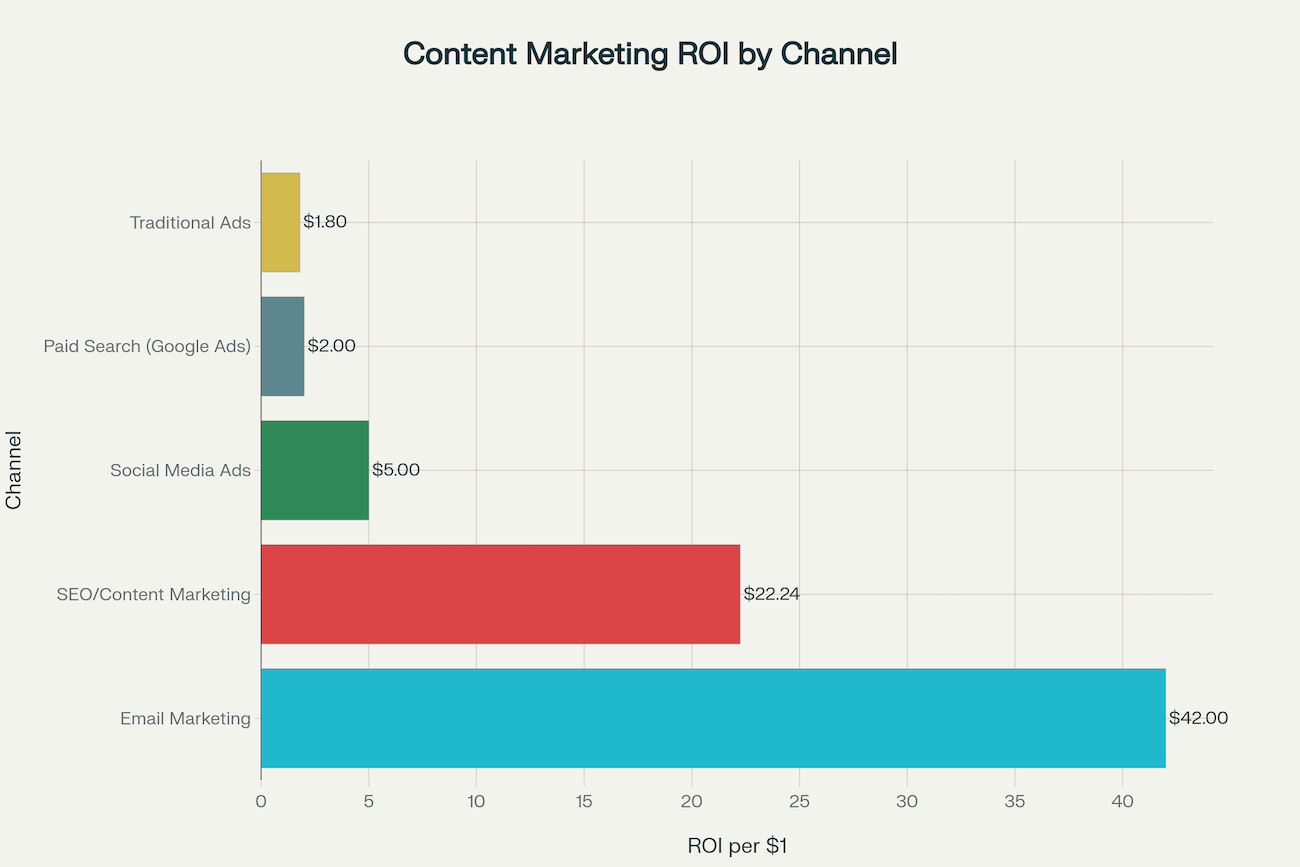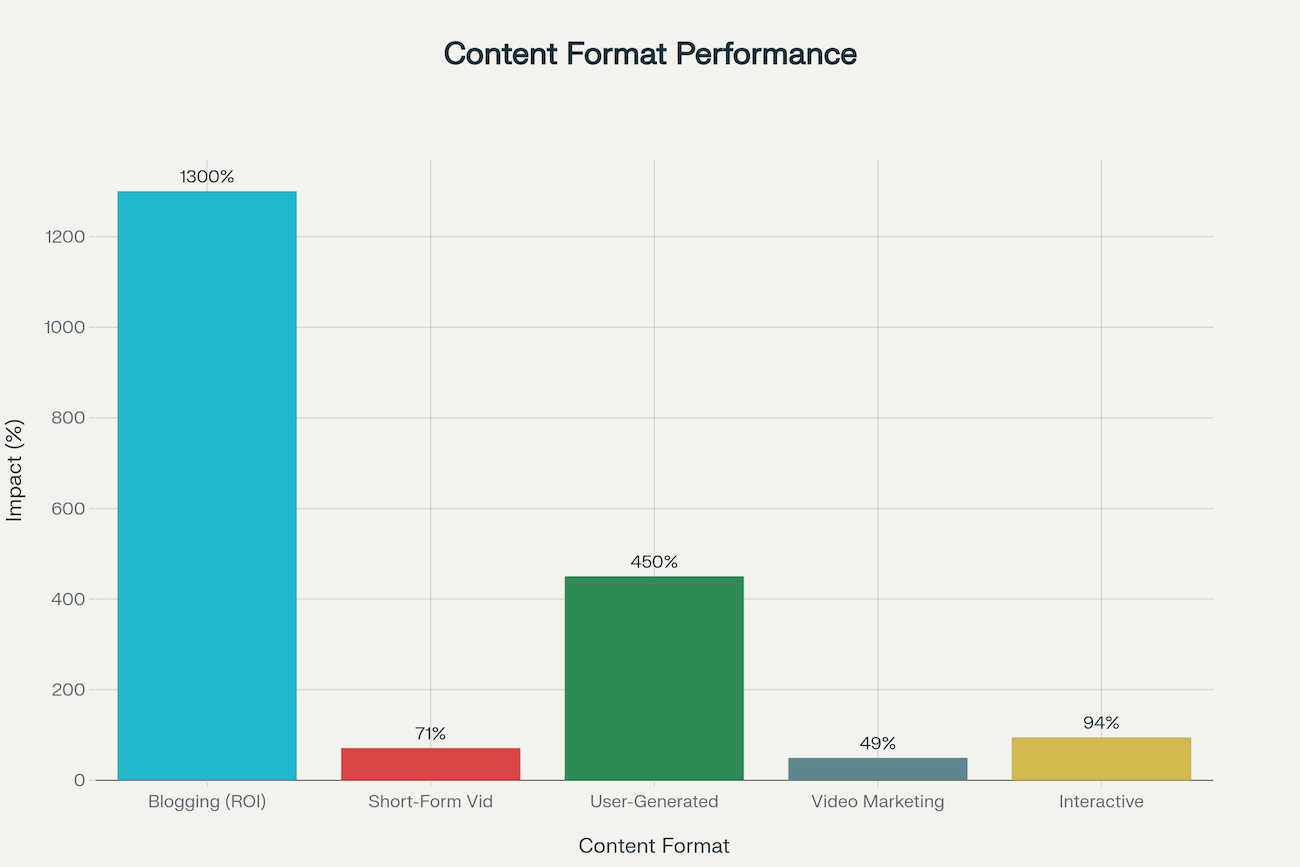Content marketing transforms how small businesses attract customers, build authority, and dominate search rankings. Rather than interrupting potential customers with ads, content marketing provides value that draws them naturally to your brand. This comprehensive guide reveals proven strategies that deliver measurable results without draining your budget.
Why Content Marketing Powers Small Business Success
Content marketing generates three times more leads than traditional marketing while costing 62% less. Small businesses embracing content marketing witness remarkable growth: companies that blog consistently experience 13 times more positive ROI than those that don’t. These numbers reveal why savvy entrepreneurs prioritize content creation over expensive advertising campaigns.
The landscape shifted dramatically in 2025. With 83% of marketing leaders now prioritizing ROI demonstration, content marketing proves its worth through trackable metrics. Search engines reward valuable content with higher rankings, social media amplifies reach, and quality content builds trust that converts browsers into buyers.

Understanding Content Marketing ROI: Where Your Investment Delivers Results
Different marketing channels produce vastly different returns. Email marketing leads the pack with an astounding $42 return for every $1 spent, followed closely by SEO and content marketing at $22.24 per dollar invested. Traditional advertising methods pale in comparison, with paid ads typically returning just $1.80 for each dollar spent.
This dramatic difference explains why over half of all businesses planned to increase their content marketing budgets in 2024. Smart small business owners recognize that content creates lasting value. A single blog post can attract visitors for years, while a paid ad disappears the moment you stop funding it.
Essential Content Marketing Strategies That Drive Traffic and Sales
Build Your Foundation With Audience-Focused Content
Successful content marketing begins with crystal-clear audience understanding. Define your ideal customer by identifying their pain points, questions, and preferred content formats. Create content that solves real problems rather than simply promoting your services.
Demographics matter less than psychographics. Understanding what keeps your audience awake at night, which platforms they frequent, and how they search for information enables you to craft content that resonates deeply. This targeted approach transforms casual readers into engaged prospects.
Master SEO Integration for Maximum Visibility
Content marketing and SEO form an inseparable partnership. Begin with thorough keyword research using tools like Google Keyword Planner, SEMrush, or Ahrefs. Target both short-tail keywords for broad reach and long-tail keywords for qualified leads.
Optimize every piece strategically by incorporating relevant keywords naturally into titles, headings, meta descriptions, and body text. Avoid keyword stuffing, which damages readability and rankings. Structure content with clear H1, H2, and H3 headings that guide both readers and search engines through your message.
Technical SEO elements amplify your content’s performance. Ensure mobile-friendliness, fast page loading speeds, and logical site structure. Add descriptive alt text to images, create internal links between related pages, and submit XML sitemaps to search engines.
Leverage High-Impact Content Formats

Different content formats serve distinct purposes and audiences. Diversifying your content mix maximizes reach while catering to varied consumption preferences.
Blog posts remain fundamental for SEO, providing detailed explanations and evergreen value. Well-optimized blog content attracts organic traffic for years, establishing your expertise while targeting specific keywords.
Short-form video dominates 2025’s content landscape. Platforms like TikTok, Instagram Reels, and YouTube Shorts deliver exceptional engagement, with 71% of video marketers reporting short-form content generates the highest ROI. Small businesses create compelling short videos using smartphones—expensive production isn’t necessary.
User-generated content (UGC) builds authenticity that branded content cannot match. Customers trust peer recommendations over company messaging, with UGC influencing 90% of shoppers’ buying choices. Encourage customers to share experiences, tag your business, and create content featuring your products or services.
Case studies and testimonials provide powerful social proof. They showcase real results, addressing skepticism while demonstrating value. Video testimonials prove especially compelling, combining authenticity with engaging visuals.
Interactive content generates 52.6% more engagement than static content, with businesses using interactive elements experiencing 94% higher content views. Quizzes, calculators, polls, and interactive infographics invite participation that deepens engagement.
Creating Viral Content That Amplifies Your Reach
Viral content isn’t accidental—it follows proven patterns. Small businesses can engineer shareability by understanding what compels people to spread content across their networks.
Trigger Emotional Responses
Content that evokes strong emotions—whether inspiration, humor, surprise, or empathy—gets shared exponentially more than neutral content. Tell authentic stories that showcase your brand’s human side. Behind-the-scenes content, founder stories, and customer transformation narratives create emotional connections that viewers want to share.
Embrace Authenticity Over Polish
Raw, genuine content outperforms overproduced material on social platforms. TikTok users particularly value authenticity, preferring relatable content over slick advertisements. Share real moments, honest reactions, and unfiltered glimpses into your business operations.
Leverage Trending Formats and Sounds
Monitor trending topics, sounds, and formats on your target platforms. Adapt trends to fit your brand rather than forcing unrelated content. Quick response to emerging trends positions your brand as current and culturally aware.
Encourage Participation and Sharing
Interactive prompts drive engagement that algorithms reward. Ask questions in captions, create “this or that” polls, run contests, and invite followers to share their experiences. Each interaction increases your content’s visibility while building community.
Strategic Content Distribution: Getting Your Content Seen
Creating brilliant content means nothing if nobody sees it. Strategic distribution ensures your carefully crafted messages reach target audiences across multiple touchpoints.
Owned Media Channels
Your website and email list form your owned media foundation. Blog content lives on your site, building SEO authority over time. Email newsletters deliver content directly to engaged subscribers, generating strong ROI through personalized communication.
Earned Media Amplification
Quality content naturally attracts backlinks, social shares, and media mentions. These earned signals boost SEO while expanding reach to new audiences. Guest posting on relevant industry sites, participating in podcasts, and engaging with journalists amplifies your message through established platforms.
Paid Media Enhancement
Strategic paid promotion accelerates content distribution. Social media ads target specific demographics with precision, while sponsored content reaches audiences on platforms they already trust. Even modest budgets can significantly expand reach when targeting is precise.
Social Platform Optimization
Each social platform demands tailored approaches. Instagram favors visual storytelling and Reels, LinkedIn rewards professional insights and thought leadership, TikTok thrives on authentic short videos, and Facebook builds community through groups and engagement.
Repurpose content across platforms to maximize efficiency. Transform blog posts into social snippets, convert webinars into YouTube videos, and extract podcast quotes for Instagram graphics. This strategic repurposing extends content lifespan while meeting audiences where they consume content.
Building Your Content Calendar for Consistent Success
Consistency separates successful content marketing from sporadic efforts that fail to gain traction. A well-planned content calendar maintains steady output while reducing stress and last-minute scrambling.
Establishing Your Publishing Cadence
Determine realistic publishing frequency based on resources. Quality consistently beats quantity—better to publish one exceptional piece weekly than five mediocre posts. Analyze audience behavior to identify optimal posting times when engagement peaks.
Structuring Your Calendar
Include essential details for each content piece: topic, format, publish date, responsible team member, target keywords, and distribution channels. Color-code different content types for visual clarity. Plan at least one month ahead while remaining flexible for timely topics.
Tools That Streamline Planning
Multiple tools simplify content calendar management. Google Sheets provides free, collaborative planning. Trello and Asana offer visual project management. Specialized tools like CoSchedule and Hootsuite integrate scheduling with social media management. Choose tools matching your budget and workflow complexity.
Maintaining Flexibility
While consistency matters, rigid adherence to outdated plans undermines effectiveness. Review content performance regularly, adjust strategies based on analytics, and stay responsive to industry developments. Swap underperforming content types for formats generating better engagement.
Content Marketing Measurement: Tracking What Matters
Measuring content marketing success requires tracking metrics aligned with business objectives. Vanity metrics like raw follower counts provide limited insight—focus instead on indicators that reflect genuine business impact.
Establishing Baseline Metrics
Document current performance before implementing new strategies. This baseline enables accurate measurement of improvement over time. Track metrics consistently using the same tools and methodologies to ensure data comparability.
Setting Realistic Goals
Align content goals with broader business objectives. If you need more qualified leads, prioritize conversion metrics. For brand awareness campaigns, focus on reach and engagement indicators. Specific, measurable goals enable clear success evaluation.
Regular Performance Reviews
Schedule monthly or quarterly content audits examining what works and what doesn’t. Identify top-performing pieces and analyze their success factors. Replicate winning elements while eliminating or improving underperforming content.
Advanced Content Marketing Tactics for Competitive Advantage
AI-Powered Content Creation
67% of small businesses now leverage AI tools for content marketing. AI streamlines research, generates initial drafts, and suggests optimization improvements. However, maintain your authentic brand voice—AI assists human creativity rather than replacing it.
Micro-Influencer Partnerships
Collaborating with niche creators who authentically align with your brand generates 4.5 times higher conversion rates than traditional advertising. Micro-influencers maintain engaged audiences who trust their recommendations. Partner with creators whose followers match your target demographic.
Video Content Optimization
Video content delivers ROI 49% faster than text-based content. Optimize videos for search by including keyword-rich titles, detailed descriptions, and accurate transcripts. Create compelling thumbnails and hooks that capture attention within the first three seconds.
Evergreen Content Strategy
Evergreen content remains relevant indefinitely, continually attracting visitors without constant updates. Comprehensive guides, how-to tutorials, and educational resources provide lasting value. Balance timely content addressing current trends with evergreen pieces that generate ongoing traffic.
Common Content Marketing Mistakes to Avoid
Inconsistent Publishing
Sporadic content creation confuses audiences and signals unreliability. Algorithms favor consistent publishers, making irregular posting doubly damaging. Start with manageable frequency you can sustain long-term.
Ignoring Search Intent
Creating content without understanding why people search for specific keywords wastes effort. Analyze search results to determine whether users want information, comparisons, or purchase options. Match content format to search intent.
Neglecting Content Distribution
Publishing content without promotion ensures minimal visibility. Allocate time and resources to distribution—even exceptional content needs strategic amplification. Plan distribution simultaneously with creation.
Failing to Repurpose Content
Creating everything from scratch is inefficient. Transform high-performing content into multiple formats: convert blog posts into videos, extract social media quotes, create infographics from data, and compile related articles into downloadable guides.
Overlooking Mobile Optimization
With mobile traffic dominating web usage, mobile-unfriendly content alienates the majority of your audience. Test content on various devices, ensure fast loading speeds, and prioritize readable formatting on smaller screens.
Implementing Your Content Marketing Strategy: Next Steps
Transform this knowledge into action with a structured implementation plan. Begin by auditing existing content to identify gaps and opportunities. Research competitors to understand what resonates in your industry. Define clear goals aligned with business objectives.
Start small with one or two content formats matching your strengths and audience preferences. Blog posts provide foundational SEO benefits, while short-form video delivers quick wins on social platforms. Build confidence and systems before expanding to additional formats.
Invest in essential tools that streamline workflow. Google Analytics tracks performance, keyword research tools identify opportunities, and content calendar systems maintain organization. Free options exist for most needs—upgrade as your strategy scales.
Most importantly, maintain consistency over perfection. Imperfect content published regularly outperforms flawless content posted sporadically. Learn from performance data, refine your approach continuously, and stay committed to providing genuine value.
Transform Your Business With Strategic Content Marketing
Content marketing empowers small businesses to compete effectively against larger competitors with exponentially bigger budgets. By creating valuable content that serves audience needs, optimizing for search visibility, and distributing strategically across relevant channels, you build sustainable growth engines that compound over time.
The businesses thriving in 2025’s digital landscape aren’t necessarily the ones spending most on advertising—they’re the ones consistently delivering content that educates, entertains, and solves real problems. Start implementing these strategies today, measure results diligently, and refine your approach based on what works for your unique audience.
Ready to elevate your content marketing and dominate search results? Partner with experts who understand what drives rankings and conversions. Discover proven strategies tailored for small businesses through our affordable SEO services for small business, where we combine content marketing excellence with technical SEO mastery.
Get your free quote and discover how strategic content marketing can transform your online visibility. Visit our contact page to start building your content marketing success story today.






